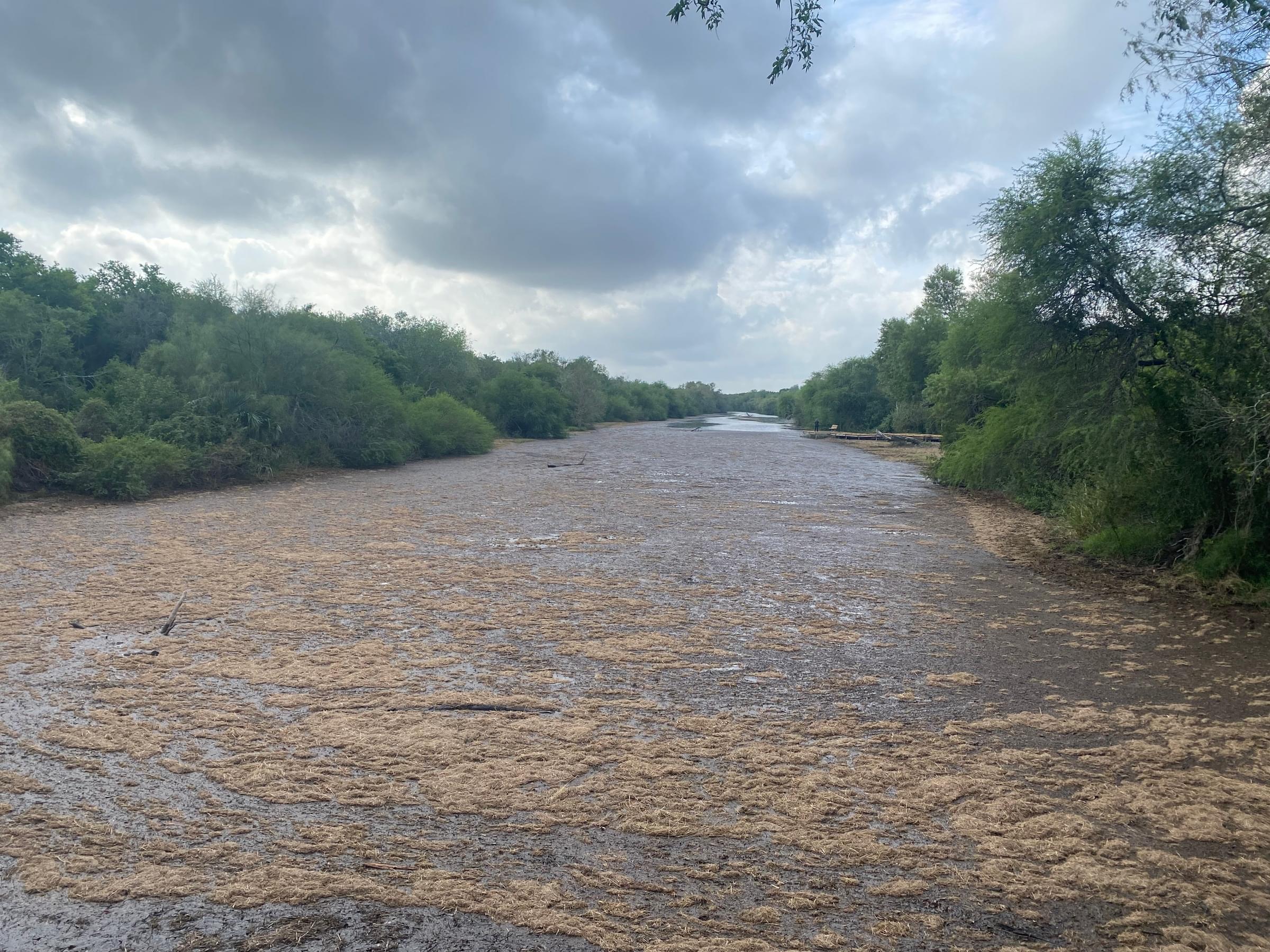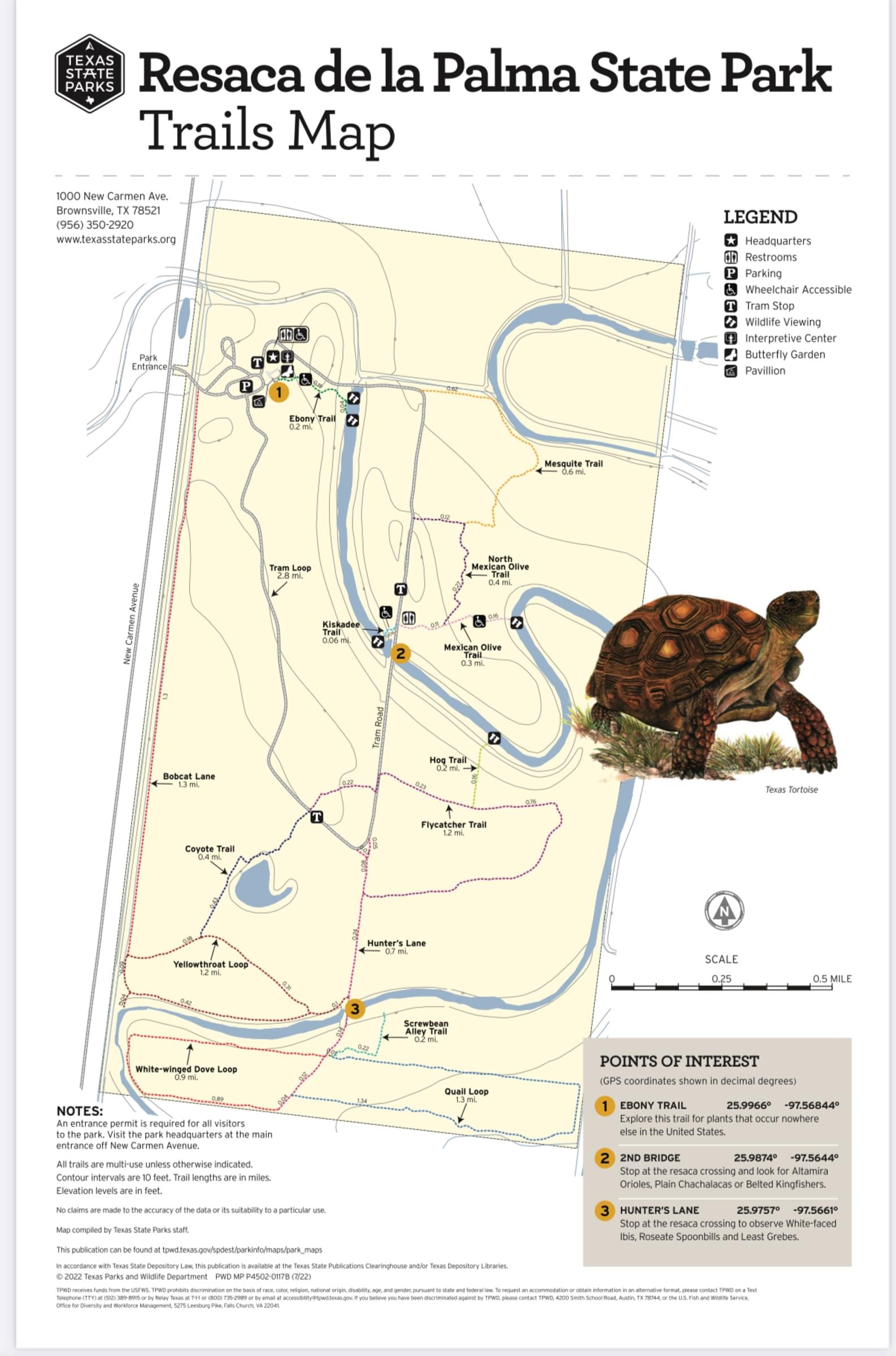Resaca de la Palma SP WBC (Brownsville) (LTC 048)

Resaca de la Palma SP WBC (Brownsville) (LTC 048)
1000 New Carmen Avenue Brownsville, Texas 78520
Official WebsiteTrails Page
Trail Map
Tips for Birding
Check-in at the main park entrance first to obtain your entrance permit. There is a per-person entrance fee to use the state park. A state park pass might be a wise investment if multiple people are birding or if you think you will be accessing a Texas State Park multiple times over the next 12 months (which is highly likely if you are birding in the valley for several days).
Check here to see if a state parks pass is right for you: https://tpwd.texas.gov/state-parks/park-information/passes/park-passes
While at the headquarters, be sure to talk with the staff or check the whiteboard to learn what birds are being seen in the park.
Most of the staff are extremely familiar with the birds in the park and will be happy to direct you toward whatever specialty bird you might want to find.
The best way to bird Resaca de la Palma State Park is to begin at the parking lot and scour the trees and feeders scattered about. A good number of birds can be found in that area.
Then proceed to the photo blind and feeding station behind the visitor center. A trail off to the right of the blind area winds through thick brush and exits at a viewing platform overlooking the Resaca.
Returning from there it would be best to walk the main tour road to the bridge crossing the Resaca and beyond.
Check with park staff to determine if scheduled birding tours are available or if guided tram tours are also available. The website might answer those questions.
A variety of other trails offer additional features of the park and should be investigated if time permits. You never know what you might encounter!!
The majority of birds that inhabit this park are typical of what you might encounter across a region. One specialty bird to look for would be the Northern Beardless-Tyrannulet. Yet rarities are always possible.
Birds of Interest
Some past rarities include:
- Blue Bunting
- Rose-throated Becard
- Crimson-collared Grosbeak
- Tropical Parula
- Roadside Hawk
About this Location
From the Texas State Parks website
The Hidden Treasure of South Texas
Welcome to Resaca de la Palma State Park! Lush woodlands of Texas ebony and anacua trees border the resaca, or oxbow lake, running through the park. Explore over 10 miles of nature trails or relax on the tram as it navigates through the well-preserved ecosystem. Make sure to stop by the Visitor Center to check out the gift shop and butterfly gardens. Tram rides are available Wednesday through Sunday.
Rio Grande Treasure
The Rio Grande etched the land in South Texas, and the result here is a semi-tropical paradise. Resaca de la Palma provides a peaceful refuge for both wildlife and people.
What is a Resaca
A resaca is the Spanish word for an Oxbow Lake. So, a Resaca is an old meandering bend of the Rio Grande River that was cut off in a subsequent flood, leaving a curved lake or dry river bed behind.
Resaca de la Palma is the Resaca of the Palms.
Long before humans arrived, the Rio Grande was shaping Resaca de la Palma.
Flooding of the Rio Grande formed the resaca or dry riverbed. These abandoned coils of riverbed attracted wildlife in wet seasons. Today, the park maintains water levels in the resaca year-round, when possible. The resaca supports a variety of habitats that are vital for the survival of wildlife.
Along the natural levees of the resaca are dense stands of banco woodlands and marsh vegetation. Away from the resaca, you’ll find drier Taumaulipan thorn woodlands with mesquite, ebony and anacua trees.
The park has three main habitats:
- 60 acres of wetland
- 420 acres of mature woodland dominated by ebony trees
- 720 acres of woodland and savannah habitats dominated by mesquite.
These habitats support diverse plants and animals, including several endangered species and species occurring nowhere else in the United States.
Throughout these habitats, you will find birds.
The Birds
Resaca de la Palma is an especially rich birding environment. Colorful migrating birds are often seen here — like the Summer Tanager, American Redstart and Yellow-breasted Chat.
White-tipped Doves and Green Jays call from within the hackberry forest and migrating warblers forage for insects on the hackberry tree leaves.
In the ebony forest, a Groove-billed Ani quietly watches people. White-eyed Vireos and Long-billed Thrashers nest in the dense vegetation.
Olive Sparrows and Northern Mockingbirds sing as they forage through the thorn-scrub.
In the grasslands, White-tailed Kites, Harris's Hawks and other raptors search for prey. Northern Bobwhites call from the grass, where they nest and raise young.
In the resaca itself, Least Grebes, Green Herons, Black-bellied Whistling-Ducks and other water birds forage through the water and mud.
For more information:
Walking along the banks of the park’s ancient resaca is like taking a tour through history. Flooding of the fourth largest river in the United States, the Rio Grande, formed this land.
A tropical forest grows along the banks of the resacas. These are likely the same trees that blocked the Spanish conquistadors when Nunez Cabeza de Vaca led his expedition to explore the Rio Grande in 1535.
Restoration
Texas Parks & Wildlife Department opened Resaca de la Palma in 1977 as a Wildlife Management Area. Biologists re-introduced native plants to land that had been used for agriculture.
In 2008, Resaca de la Palma opened as a state park.
Things to Do
Explore over eight miles of trails, watch for wildlife from one of four decks overlooking the Resaca, take a tram tour or attend a ranger program. Group sites may be reserved for gatherings.
Park store
The park store offers shopping and rentals.
Choose a field guide or book, t-shirt, hat or other gift items. We also have cold drinks, snacks and ice cream.
Rent one of the following items to use in the park:
- Bicycles (must be returned by 3 p.m.):
- Regular and children’s bikes (no training wheels): $5 per day
- Adult tricycles and children’s carrier with bike: $8 per day
- Binoculars: $3 per day
Get Involved
Volunteers help with programs, outreach, office duties and maintenance. If your group wants to volunteer or you need volunteer hours, call ((956) 350-2920) or visit the headquarters.
Support state parks by donating to the Texas Parks & Wildlife Foundation.
Ranger Programs
The park offer programs on the nature and history of this area. Visit the park's Events page for upcoming programs.
Custom nature programs for your group are available. Call (956) 350-2920 for information.
Kids
Become a Junior Ranger!
- Borrow an Explorer Pack, with tools for exploring nature.
- Complete activities in our Activity Journal to earn a badge.
Teachers
The park offers year-round field trips! Call the park headquarters for information.
Area Attractions
Resaca de la Palma is in Brownsville, about a 40-minute drive from South Padre Island and Brownsville’s historic downtown. There you’ll find many restaurants, museums, bicycle trails and the Gladys Porter Zoo.
Notable Trails
The following information is from the AllTrails website: https://www.alltrails.com/trail/us/texas/mesquite-mexican-olive-tram-road-flycatcher-yellowthroat-loop
Features
Restrooms on site
Wheelchair accessible trail
Entrance fee
Roadside viewing
Content from Official Website, Trails Page, and AllTrails
Last updated January 23, 2024
 Trail Map
Trail Map